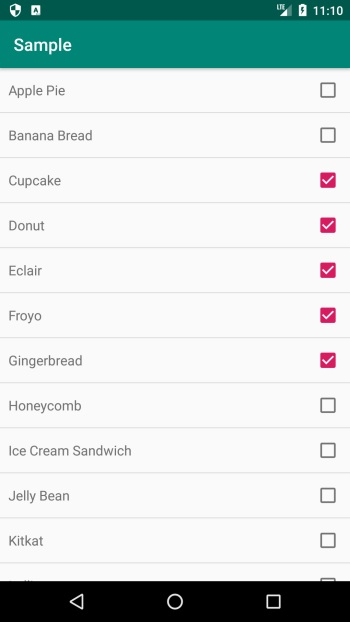
 Data Structure
Data Structure Networking
Networking RDBMS
RDBMS Operating System
Operating System Java
Java MS Excel
MS Excel iOS
iOS HTML
HTML CSS
CSS Android
Android Python
Python C Programming
C Programming C++
C++ C#
C# MongoDB
MongoDB MySQL
MySQL Javascript
Javascript PHP
PHP
- Selected Reading
- UPSC IAS Exams Notes
- Developer's Best Practices
- Questions and Answers
- Effective Resume Writing
- HR Interview Questions
- Computer Glossary
- Who is Who
How to bind data from a database to an Android CheckBox in a ListView?
This example demonstrates how to bind data from a database to an Android CheckBox in a ListView.
Step 1 − Create a new project in Android Studio, go to File ⇒ New Project and fill all required details to create a new project.
Step 2 − Add the following code to res/layout/activity_main.xml.
<?xml version="1.0" encoding="utf-8"?> <androidx.constraintlayout.widget.ConstraintLayout xmlns:android="http://schemas.android.com/apk/res/android" xmlns:app="http://schemas.android.com/apk/res-auto" xmlns:tools="http://schemas.android.com/tools" android:layout_width="match_parent" android:layout_height="match_parent" tools:context=".MainActivity"> <ListView android:id="@+id/listView" android:layout_width="match_parent" android:layout_height="wrap_content" tools:ignore="MissingConstraints" /> </androidx.constraintlayout.widget.ConstraintLayout>
Step 3 − Add the following code to res/layout/row_item.xml.
<?xml version="1.0" encoding="utf-8"?> <RelativeLayout xmlns:android="http://schemas.android.com/apk/res/android" android:orientation="vertical" android:padding="10dp" android:layout_width="match_parent" android:layout_height="wrap_content"> <TextView android:id="@+id/txtName" android:layout_width="wrap_content" android:layout_height="wrap_content" android:layout_alignParentLeft="true" android:layout_alignParentStart="true" android:layout_centerVertical="true" android:textSize="16sp" /> <CheckBox android:id="@+id/checkBox" android:layout_width="wrap_content" android:layout_height="wrap_content" android:layout_alignParentEnd="true" android:layout_alignParentRight="true" android:layout_alignParentTop="true" /> </RelativeLayout>
Step 4 − Add the following code to src/MainActivity.java
package com.app.sample;
import androidx.appcompat.app.AppCompatActivity;
import android.view.View;
import android.widget.AdapterView;
import android.widget.ListView;
import java.util.ArrayList;
import android.os.Bundle;
public class MainActivity extends AppCompatActivity {
ArrayList dataModels;
ListView listView;
private CustomAdapter adapter;
@Override
protected void onCreate(Bundle savedInstanceState) {
super.onCreate(savedInstanceState);
setContentView(R.layout.activity_main);
listView = (ListView) findViewById(R.id.listView);
dataModels = new ArrayList();
dataModels.add(new DataModel("Apple Pie", false));
dataModels.add(new DataModel("Banana Bread", false));
dataModels.add(new DataModel("Cupcake", false));
dataModels.add(new DataModel("Donut", true));
dataModels.add(new DataModel("Eclair", true));
dataModels.add(new DataModel("Froyo", true));
dataModels.add(new DataModel("Gingerbread", true));
dataModels.add(new DataModel("Honeycomb", false));
dataModels.add(new DataModel("Ice Cream Sandwich", false));
dataModels.add(new DataModel("Jelly Bean", false));
dataModels.add(new DataModel("Kitkat", false));
dataModels.add(new DataModel("Lollipop", false));
dataModels.add(new DataModel("Marshmallow", false));
dataModels.add(new DataModel("Nougat", false));
adapter = new CustomAdapter(dataModels, getApplicationContext());
listView.setAdapter(adapter);
listView.setOnItemClickListener(new AdapterView.OnItemClickListener() {
@Override
public void onItemClick(AdapterView parent, View view, int position, long id) {
DataModel dataModel= (DataModel) dataModels.get(position);
dataModel.checked = !dataModel.checked;
adapter.notifyDataSetChanged();
}
});
}
}
Step 5 − Add the following code to src/DataModel.java
package com.app.sample;
public class DataModel {
public String name;
boolean checked;
DataModel(String name, boolean checked) {
this.name = name;
this.checked = checked;
}
}
Step 6 − Add the following code to src/CustomAdapter.java
package com.app.sample;
import android.content.Context;
import android.view.LayoutInflater;
import android.view.View;
import android.view.ViewGroup;
import android.widget.ArrayAdapter;
import android.widget.CheckBox;
import android.widget.TextView;
import androidx.annotation.NonNull;
import java.util.ArrayList;
public class CustomAdapter extends ArrayAdapter{
private ArrayList dataSet;
Context mContext;
// View lookup cache
private static class ViewHolder {
TextView txtName;
CheckBox checkBox;
}
public CustomAdapter(ArrayList data, Context context) {
super(context, R.layout.row_item, data);
this.dataSet = data;
this.mContext = context;
}
@Override
public int getCount() {
return dataSet.size();
}
@Override
public DataModel getItem(int position) {
return (DataModel) dataSet.get(position);
}
@Override
public View getView(int position, View convertView, @NonNull ViewGroup parent){
ViewHolder viewHolder;
final View result;
if (convertView == null) {
viewHolder = new ViewHolder();
convertView = LayoutInflater.from(parent.getContext()).inflate(R.layout.row_item, parent, false);
viewHolder.txtName = (TextView) convertView.findViewById(R.id.txtName);
viewHolder.checkBox = (CheckBox) convertView.findViewById(R.id.checkBox);
result=convertView;
convertView.setTag(viewHolder);
} else {
viewHolder = (ViewHolder) convertView.getTag();
result=convertView;
}
DataModel item = getItem(position);
viewHolder.txtName.setText(item.name);
viewHolder.checkBox.setChecked(item.checked);
return result;
}
}
Step 7 − Add the following code to Manifests/AndroidManifest.xml
<?xml version="1.0" encoding="utf-8"?> <manifest xmlns:android="http://schemas.android.com/apk/res/android" package="com.app.sample"> <application android:allowBackup="true" android:icon="@mipmap/ic_launcher" android:label="@string/app_name" android:roundIcon="@mipmap/ic_launcher_round" android:supportsRtl="true" android:theme="@style/AppTheme"> <activity android:name=".MainActivity"> <intent-filter> <action android:name="android.intent.action.MAIN" /> <category android:name="android.intent.category.LAUNCHER" /> </intent-filter> </activity> </application> </manifest>
Let's try to run your application. I assume you have connected your actual Android Mobile device with your computer. To run the app from the android studio, open one of your project's activity files and click Run ![]() icon from the toolbar. Select your mobile device as an option and then check your mobile device which will display your default screen −
icon from the toolbar. Select your mobile device as an option and then check your mobile device which will display your default screen −

Click here to download the project code.

